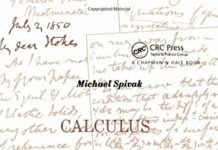
Ebook Info
- Published: 1999
- Number of pages:
- Format: PDF
- File Size: 5.66 MB
- Authors: Michael Spivak
Description
Spivak’s 5 volume set is a classic and overall the best and most thorough treatment of differential geometry
User’s Reviews
Reviews from Amazon users which were colected at the time this book was published on the website:
⭐This book is the first volume of the 3rd edition in a five volume series on differential geometry. The emphasis on this first volume is the study of differential forms and de Rham Cohomology Theory. Spivak also considers two ‘bonus’ topics: integral manifolds & foliations and Lie groups.You’ll need some prerequisites to get started. For the differential topology material (including Sard’s Theorem and Whitney’s 2n+1 Embedding Theorem), I recommend Hirsch’s
⭐. For results on determinants and symmetric groups, I use Hungerford’s
⭐, now in its 12th printing. For the general topology material (Hausdorff spaces, Urysohn metrization, etc.), I recommend Munkres’
⭐.Spivak begins this volume with a review of topological manifolds in Chapter 1. The author provides the basic definitions and gives lots of examples of surfaces and other manifolds. The discussion of manifolds and surfaces continues in the Chapter 1 Exercises. (The author routinely used the exercise set to continue the thread of discussion.) Quick mention of the surface classification theorem is made, although for the proof of this, you’ll need to look in Hirsch or Munkres. The reader gets to have fun gluing topological handles onto and cutting disks out of the 2-sphere.Chapter 2 reviews some of the basic concepts from differential topology, including the fundamental Whitney Embedding Theorem and Sard Critical Point Theorem. Basic properties of smooth maps are also studied.Chapter 3 studies the general vector bundle and specializes to the tangent bundle of a smooth manifold. The author is keen on the idea that the reader ‘grok’ (i.e. understand intuitively) the tangent bundle and the associated induced maps and commutative diagrams. The notion of orientability is also introduced.Multilinear forms and their tensor product are studied in Chapter 4. This is a key building block in the construction of de Rham cohomology. The author gets side tracked a bit with a discussion of differences in classical/modern notion.Chapter 5 is a very nice chapter on vector fields. Instead of just appealing to results from differential equations (as is usually done) to build integral curves and the flow of a vector field, Spivak establishes these needed results from differential equations using a very accessible integral equations/fixed point argument. Once the flow of a vector field is show to exist (locally), Lie derivatives and Lie brackets are then studied.Following the integral curves & vector fields material in the previous chapter, the author detours a bit and studies the problem of integral manifolds of dimensions other than 1 along with applications to foliations in Chapter 6. Spivak establishes a basic version of the Frobenius Integrability Theorem and uses examples to motivate the result before diving into the proof.The basics of de Rham cohomology are established in Chapter 7 and Chapter 8. Alternating and skew-symmetric forms are discussed, although is may be easiest to establish some of the needed results on the symmetric group of permutations after reviewing Hungerford’s
⭐. Differential forms and their wedge product are defined, and Frobenius’ Theorem can now be restated in terms of differential forms. Two versions of Stokes Theorem are established and this result is applied to integrating forms on manifolds and studying properties of the degree of a proper map of between manifolds. The formal definition of the de Rham cohomology groups is given and some basic calculations are carried out.The author does something curious with one of the main results of de Rham cohomology, namely the homotopy-invariance property. He starts this with a discussion section in Chapter 7 (not a called out theorem) in which contractible manifolds are show to have zero cohomology in all dimension by an explicit calculation showing all closed k-forms are exact. The results that the author establishes in Chapter 7 for this `one-off’ calculation are precisely what are needed to show the more general result that homotopic maps induce equivalent homomorphisms of de Rham cohomology later in Chapter 8.Chapter 9 is a very nice chapter covering several foundational topics of Riemannian geometry; include the Riemannian metric, geodesics, the exponential map, geodesic completeness and tubular neighborhoods.Chapter 10 is a short chapter on Lie groups and is something of a detour from the main thread. The author uses the material as a source of application of the material from the first nine chapters.Returning to de Rham cohomology in Chapter 11, more foundational results from algebraic topology are studied, including exact sequences, Poincare Duality, the Thom class and the index of a vector field.The book contains many wonderful geometric diagrams which help motivate the material. In most cases, the author is very careful to highlight theorems, propositions and lemmas. Occasionally key results will be ‘buried’ in a series of discussion paragraphs, which makes referring to these results later on somewhat difficult. The author never, ever calls out or highlights any of his definitions. This can be somewhat frustrating, especially when trying to track down one of these definitions. Fortunately the index to the book is reasonably good.
⭐Intuitive text on manifolds. Modern books I’ve looked at introduce tons of machinery without many example. This book walks the reader through classical examples and motivates algebra with intuition. Exercises are really good level of difficulty. Requires a fair amount of basic topology. Excellent background to read Hatcher “Algebraic Topology” and understand the examples geometrically while learning algebraic techniques.
⭐Like a constrictor eating an antelope, it’s going to take a while for this encyclopedic work to go down my brain gullet. It’s made all the more daunting by the knowledge that this is just the first of five massive volumes! Nevertheless, several thoughts have already come to mind. (The star rating is therefore provisional.)This book spends the first half of its pages on some of the key constructions for differentiable manifolds, with the remainder taken up by integration on manifolds, de Rham cohomology, Lie groups and a foray into algebraic topology. Of note, the author’s comparison between classical and modern differential geometry language is especially illuminating and allows one to appreciate the accomplishments of Gauss and Riemann, who discovered many important theorems of differential geometry without the benefit of modern, rigorous definitions. (The English translation of their writings and a “translated” version in modern terms is included in Volume 2.)The author doesn’t spare the reader of any of the gory details, which is good and bad — good in the sense that difficult concepts and abstract constructions are explained thoroughly (in stark contrast to his ostensibly elementary book “Calculus on Manifolds”), bad in the sense that one feels compelled to skip around, at least on first reading. In one particular case (a diagram chasing proof that constructs the natural isomorphisms between equivalent constructions of the tangent bundle), the author even encourages it: (p. 86) “The details of this proof are so horrible that you should probably skip it (and you should definitely quit when you get bogged down); the welcome [end-of-proof symbol] occurs quite a ways on.”Nevertheless, the book is informal and quite readable, with the author’s quirky humor shining through in its pages (as the quote above provides an example of).
⭐This was one of the books that helped me decide to get a phd in math (even though I didn’t officially study differential geometry). Spivak’s books read like chalkboard lectures by a superb lecturer. The examples stretched my imagination. In particular the exercises from chapter 1 are really good. There is the tessellation of a cylinder that has arbitrarily high area, the tubey version of the infinite binary tree homeomorphic to R^2 minus the usual Cantor set.The previous edition had a bad cover material and I ended up needing a new copy because the binding broke. But you don’t judge a book by its cover, rather its contents. The cover art is cool too.
⭐If you want a book that is rich with examples then this is it. The proofs are, for the most part, clear and concise, thus a person who is learning the material without the aid of an instructor can follow the logic. However, the author could have spent some more time developing topological ideas (thought he does have an appendix section that does a fair job of it) within the flow of the first chapter. I personally find appendices to be too distracting and tend to slow down the flow of the material in a particular chapter. Other than that, this is a great book if you want to learn differential geometry and the theory of smooth manifolds.
⭐Spivac, the man of differential geometry. There is nothing to say this is a masterpiece any one who wants to be on the subject Spivac is the book
⭐It.s Ok
⭐It’s a classic but the new edition looks better and of course the contents are all that you need to know for a course of DG/Riemannian Geometry.
⭐I don’t have read this book yet, but as it was suggested by an expert of differential geometry, I purchased it. But, the point I want to mention is the following. In the product information, Amazon said “23.6 x 16.3 x 3.3 cm”. I thought then the books would be almost A4-paper size; but this is not the case; the difference in length and breadth was 2 to 3 cm less.On Amazon, there is an advertisement of “five volumes together at Rs. + – 10,000”; The difference in “collected series” and “single copy” was of dimensions (length-breadth). I purchased these costly books i.e. single copy, and found that the actual dimensions are less than that posted on website.
Keywords
Free Download A Comprehensive Introduction to Differential Geometry, Vol. 1, 3rd Edition 3rd Edition in PDF format
A Comprehensive Introduction to Differential Geometry, Vol. 1, 3rd Edition 3rd Edition PDF Free Download
Download A Comprehensive Introduction to Differential Geometry, Vol. 1, 3rd Edition 3rd Edition 1999 PDF Free
A Comprehensive Introduction to Differential Geometry, Vol. 1, 3rd Edition 3rd Edition 1999 PDF Free Download
Download A Comprehensive Introduction to Differential Geometry, Vol. 1, 3rd Edition 3rd Edition PDF
Free Download Ebook A Comprehensive Introduction to Differential Geometry, Vol. 1, 3rd Edition 3rd Edition





